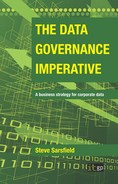Book Description
Take control of your data for a more intelligent, responsive business
Proactive management of your corporate information has never been more important. Data governance isn't a challenge solely for the IT team - it's every inch a business issue.
Seamless processes and a personal commitment to clean data give you the ability to generate accurate business intelligence and financial reports, and gain an instant snap shot of the health of your business. Most importantly, they also help you run a more intelligent, agile, fast-moving business than your competitors.
The Data Governance Imperative is written from a business person's view of data governance. This practical book covers both strategies and tactics around managing a data governance initiative.
Benefits to business include:Table of Contents
- FOREWORD
- PREFACE
- ABOUT THE AUTHOR
- ACKNOWLEDGEMENTS
- CONTENTS
- CHAPTER 1: THE NEED FOR DATA GOVERNANCE
- Sins of the past
- Where are the metrics?
- Unnecessary complexity
- ETL and data warehouse
- Building more efficiency
- The value of an acquisition
- Decisions based on gut
- Data governance and being green
- Improving compliance with BASEL II and SOX
- Designated terrorist organizations
- Why data governance?
- Who needs data governance?
- CHAPTER 2: WHAT IS DATA GOVERNANCE?
- CHAPTER 3: DEFINING DATA GOVERNANCE SUCCESS
- CHAPTER 4: GETTING FUNDED FOR IQ PROJECTS
- CHAPTER 5: PEOPLE – WHAT DOES A DATA GOVERNANCE TEAM LOOK LIKE?
- CHAPTER 6: PAINTING THE PICTURE
- CHAPTER 7: FIXING YOUR DATA
- CHAPTER 8: TECHNOLOGIES THAT SUPPORT DATA GOVERNANCE
- CHAPTER 9: THE AUDACITY OF DATA GOVERNANCE
- CHAPTER 10: CASE STUDY – BT
- ITG RESOURCES
